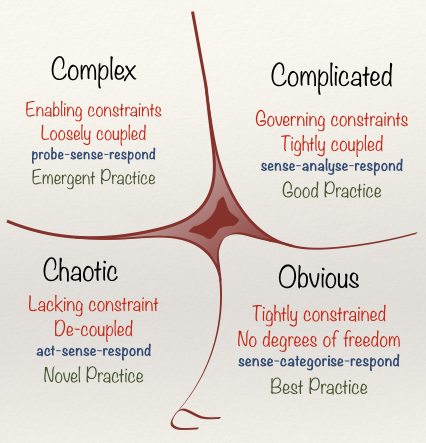Understanding the Cynefin Framework in Agile Methodology
We deliver better results for our clients when we embrace uncertainty with an Agile mindset.

Over the years, there have been several unsuccessful attempts to simplify and standardize our work at Palantir. As we began work on our redesign project last year, I became aware of Cynefin, a sense-making framework that helped explain not only why those past efforts had failed, but why that failure was inevitable and helped point the path toward embracing uncertainty with an Agile mindset.
The Basics of Cynefin
Cynefin is a sense-making framework developed in the 1990s by Dave Snowden that recognizes the causal differences that exist between system types and proposes new approaches to decision-making in complex social environments.
The Cynefin model describes five different domains: Obvious, Complicated, Complex, Chaotic and Disorder. The first four are listed in order of decreasing causality whereas Disorder is a human space where we simply do not know what type of system we are in.

Snowden [CC BY-SA 3.0], via Wikimedia Commons
In the Obvious domain cause and effect are directly connected, whereas in a Chaotic domain there are no patterns and the relationship between cause and effect are unclear.
The Complicated domain consists of "known unknowns", where determining the relationship between cause and effect requires analysis or expertise and there are a range of right answers. In Complex environments, causes are understandable retrospectively (i.e. with hindsight) so that an adaptive approach to change is more appropriate (more chances to integrate that reflection into designing and refining the final outcome).
Cynefin Framework and Agile Methodology
Consultancies like Palantir are brought in to help solve problems that fall in the “Complicated” and “Complex” domains. Upon reflection it became clear that most of our work falls into the Complex domain:
- Small decisions can have cascading and disproportionate impacts.
- The conditions and systems with and within which we work are dynamic and ever-changing.
- Our best decisions are based on past patterns drawn from our experience, rather than on logical, definable rules.
Agile is best suited toward Complex situations like this. The Agile process is structured so that teams build knowledge progressively through experimentation and iteration that ultimately are able to move the problem into the Complicated domain, where there are known unknowns and a series of potential good solutions.
Applying the Cynefin Framework in Agile Environments
Reframing our experience using Cynefin, we understand that attempts to simplify our work to checklists of repeatable best practices imply that only one solution to the problem exists and that all variables are known at the onset. Such efforts were doomed as they deny the fundamental dynamic and constraints within which we work. To capture the value of experience and expertise, we have instead shifted our approach from one of rigid process definition and documentation to building out a toolkit of methods and plays that help us capture and elevate that earned individual experience into organizational wisdom suited toward a complex environment.
All projects start off with a list of known unknowns, and well as assumptions to validate, both derived from individual and organizational experience, but Cynefin helps us also embrace that there are also unknowns (e.g., requirements, constraints, dynamics, etc.) that will be revealed over the course of the project. Those unknowns will necessarily impact not just our understanding of the problem, but also which of the many right solutions should be pursued. This uncertainty can be addressed methodically, working collaboratively and iteratively with our clients until we establish a shared, emergent understanding that gives rise to a shared vision for the outcome and the path to get there.
That evolution of understanding is an inherent part of the task at hand, not a bug to be removed through standardization. How we prepare for uncertainty, how we acknowledge it and integrate it into the process determines the satisfaction not only with the final outcome, but also with the journey we take to get there.
Benefits and Challenges
Organizations historically have often been structured to work like machines, focused on known inputs and outputs with well-established processes and procedures to get you from one to the other. People are seen as interchangeable; all projects are fundamentally knowable, and easily categorized, solved and documented. This assumption, organizations as machines, forms the baseline assumptions for many of us about how organizations and projects should run.
By embracing this uncertainty up front, we can ultimately deliver better results for our clients. As a team, we are building out a playbook of tools and structures that help us become more comfortable operating in this complexity and provide better ways to help our clients navigate it as well. Instead of focusing on outputs, our goal is to help our clients articulate desired outcomes.
The modern professional organization is not a machine and any attempts to force it into that model will come up short. Both Palantir and the clients we serve are complex adaptive systems, far more like living organisms than machines. We know from both nature and the research on effective business that the most successful organizations are the ones who know how to adapt and innovate quickly to an evolving understanding of complex situations, working as interconnected, collaborating teams of people focused on a shared goal.
Future of Agile and Cynefin
While many of us may have seen or been on teams that reach that level of performance, there are not yet as many who have experienced operating agile at the organizational level. This is the challenge ahead of us. Or, as Abraham Lincoln once put it, “As our case is new, so we must think anew, and act anew.” As we forge ahead and embed this mindset into our culture, I don’t know what I don’t know, but I do know that we’re going to experiment, learn and adapt. In that way, we’re going to figure it out together.
Maze by hélène veilleux licensed under CC BY-NC-ND 2.0.
